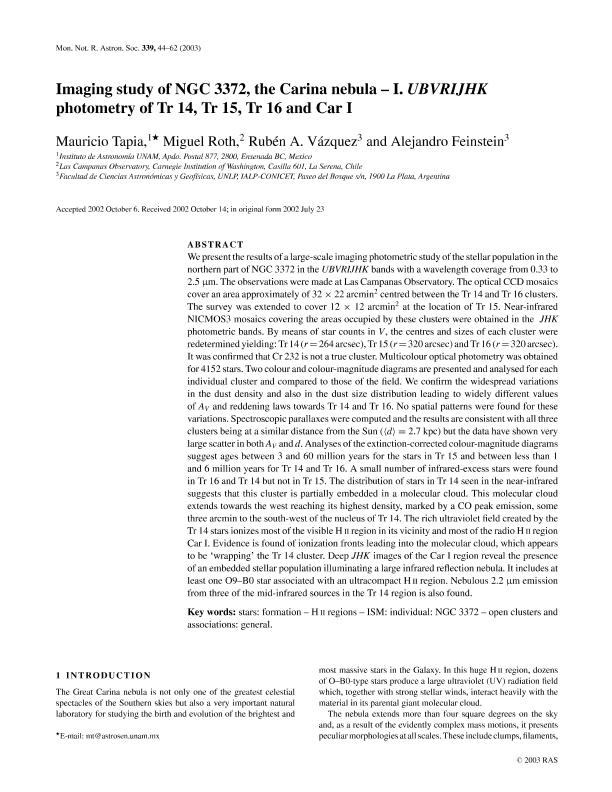Artículo
Imaging study of NGC 3372, the Carina nebula -I. UBVRIJHK photometry of Tr 14, Tr 15, Tr 16 and Car I
Fecha de publicación:
02/2003
Editorial:
Wiley Blackwell Publishing, Inc
Revista:
Monthly Notices of the Royal Astronomical Society
ISSN:
0035-8711
Idioma:
Inglés
Tipo de recurso:
Artículo publicado
Clasificación temática:
Resumen
We present the results of a large-scale imaging photometric study of the stellar population in the northern part of NGC 3372 in the UBVRIJHK bands with a wavelength coverage from 0.33 to 2.5 μm. The observations were made at Las Campanas Observatory. The optical CCD mosaics cover an area approximately of 32 × 22 arcmin2 centred between the Tr 14 and Tr 16 clusters. The survey was extended to cover 12 × 12 arcmin2 at the location of Tr 15. Near-infrared NICMOS3 mosaics covering the areas occupied by these clusters were obtained in the JHK photometric bands. By means of star counts in V, the centres and sizes of each cluster were redetermined yielding: Tr 14 (r = 264 arcsec), Tr 15 (r = 320 arcsec) and Tr 16 (r = 320 arcsec). It was confirmed that Cr 232 is not a true cluster. Multicolour optical photometry was obtained for 4152 stars. Two colour and colour-magnitude diagrams are presented and analysed for each individual cluster and compared to those of the field. We confirm the widespread variations in the dust density and also in the dust size distribution leading to widely different values of AV and reddening laws towards Tr 14 and Tr 16. No spatial patterns were found for these variations. Spectroscopic parallaxes were computed and the results are consistent with all three clusters being at a similar distance from the Sun (〈d〉 = 2.7 kpc) but the data have shown very large scatter in both AV and d. Analyses of the extinction-corrected colour-magnitude diagrams suggest ages between 3 and 60 million years for the stars in Tr 15 and between less than 1 and 6 million years for Tr 14 and Tr 16. A small number of infrared-excess stars were found in Tr 16 and Tr 14 but not in Tr 15. The distribution of stars in Tr 14 seen in the near-infrared suggests that this cluster is partially embedded in a molecular cloud. This molecular cloud extends towards the west reaching its highest density, marked by a CO peak emission, some three arcmin to the south-west of the nucleus of Tr 14. The rich ultraviolet field created by the Tr 14 stars ionizes most of the visible H II region in its vicinity and most of the radio H II region Car I. Evidence is found of ionization fronts leading into the molecular cloud, which appears to be 'wrapping' the Tr 14 cluster. Deep JHK images of the Car I region reveal the presence of an embedded stellar population illuminating a large infrared reflection nebula. It includes at least one O9-B0 star associated with an ultracompact H II region. Nebulous 2.2 μm emission from three of the mid-infrared sources in the Tr 14 region is also found.
Archivos asociados
Licencia
Identificadores
Colecciones
Articulos(IALP)
Articulos de INST.DE ASTROFISICA LA PLATA
Articulos de INST.DE ASTROFISICA LA PLATA
Citación
Tapia, Mauricio Andres; Roth, Miguel; Vazquez, Ruben Angel; Feinstein, Alejandro; Imaging study of NGC 3372, the Carina nebula -I. UBVRIJHK photometry of Tr 14, Tr 15, Tr 16 and Car I; Wiley Blackwell Publishing, Inc; Monthly Notices of the Royal Astronomical Society; 339; 1; 2-2003; 44-62
Compartir
Altmétricas




